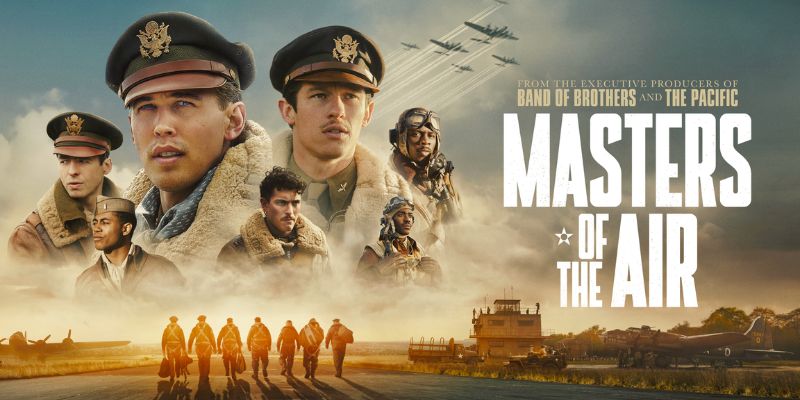Series: Masters of the Air | Streaming on: Apple TV+ | Rated: TVMA | Reviewer: James Steen
For those who love, respect and appreciate World War II dramas, “Masters of the Air” does not disappoint; in fact, it delivers historically accurate and inspiring stories of survival, heroism and patriotism that keep the audience on the edge of their seats throughout the series. “Masters of the Air” is produced by Tom Hanks and Steven Spielberg, creating a trilogy with “Band of Brothers” and “The Pacific” that tells the story of the 100th Bomb Group in the Eighth Air Force based in England. Known as the “Bloody Hundredth,” they completed 8,630 missions from June 1943 to April 1945 tragically losing 732 airmen and 177 B-17 bombers.
As expected, the cinematography, the acting and the storylines are captivating. Presumably, all of the missions, characters and locations, spanning across Europe, are factual. What is unique about this series is that it chronicles many of the details and nuances required to successfully launch bomber missions into occupied territory. For example, there is a great preflight sequence with close-up shots from the control panels in the cockpit that builds anticipation for the mission that is to ensue. They also explain how the bomber groups from various airstrips all over England come together in larger formations for the combat sorties. The series also highlights, from the ground crew’s point of view, the painstaking work of mending and repairing the B-17s after each mission and laboring all night to load ordinance into the bomb bays to prepare for the next morning’s bombing run. The series rightly celebrates the commitment and tenacity of the mechanics who are shown stripping a newly arrived B-17 of parts that are desperately needed to keep the other planes in the air, and even finishing repairs while the bombers are literally taxiing on the runway to take off again.
Most of the drama happens in the skies over western Europe with a vividly realistic portrayal of American flight crews engaged in aerial combat. From every jarring flak explosion to the relentless assaults launched by the Luftwaffe’s fighters, audiences are given a realistic and personal perspective of the intensity from each mission. The series accurately covers the various approaches to wartime bombing with Great Britain employing evening bombing tactics which were much safer for the RAF bombers, but resulted in many indiscriminate civilian casualties. Conversely, the U.S. Eight Air Force utilized daytime bombing missions that were much more strategic in terms of hitting military targets. However, daytime bombing was extremely dangerous and costly for American pilots who were susceptible to anti-aircraft guns as well as the formidable Messerschmitt Bf 109 fighter pilots. These are the most intense and difficult scenes to watch as the B-17 flight crews are practically sitting ducks on their daytime bombing runs, especially after the American fighter escorts turn back to England to avoid running out of fuel.
It is worth mentioning that all of the flying scenes are one hundred percent computer-generated imagery (CGI). Despite a few times when the CGI is fairly obvious, most viewers will be completely dazzled by the realistic graphics. There were actually only two B-17 bomber replicas used in the production for close ups and interior shots, neither of which were able to fly. Surprisingly, the scenes of the Flying Fortresses at the airfield are so real and convincing, that you would swear that the producers had access to an entire fleet of them.
Another compelling aspect of the series was seeing what flight crews experienced when forced to abandon ship over enemy territory. After airmen parachuted out of their crippled B-17s, they were shot at by enemy fighters, risked broken limbs upon a rough landing, and were almost always captured. There are several moving scenes portraying members of the 100th Bomb Group being reunited in prisoner of war camps. The episodes that explore the hardships and realities of POWs are very different than the fictional comedy “Hogan’s Heroes.” It is extremely gratifying in the final episode of the series when the POWs are finally liberated by the Allied forces.
“Masters of the Air” also highlights the Tuskegee Airmen, who flew the red-tailed P-51 Mustangs with the Fifteenth Air Force out of Italy. In one eye-opening scene, the base commander explains to Robert “Rosie” Rosenthal, who completed 52 missions with the Hundredth, that Jimmy Doolittle intended to use the bombers as bait to allow the American fighter escorts to engage the German fighters and shoot them down. Ultimately, this is how the Allies eventually gained air superiority over the Luftwaffe prior to the D-Day invasion.
Two of the main characters that the series highlights are Gale “Buck” Cleven, played by Austin Butler and John “Bucky” Egan, played by Callum Turner. The pair are best friends, but polar opposites in terms of personalities. Although Butler often slips in and out of his Elvis voice, his character, Buck, is very likable and honorable. Turner’s character, Bucky, is much more complex and often unhinged. The series also highlights Major Harry Crosby, who eventually became the Group Navigator for the 100th Bomb Group; his memoirs were a critical resource used to document many of these stories.
“Masters of the Air” does a fabulous job honoring the legacy of these brave pilots who fought in World War II to achieve victory over Europe. The series is rated TV-MA (for mature audiences) for language and violence as well as a few unnecessary sex scenes; but it is well worth the time and effort to watch all nine episodes to remind us that freedom is not free.






